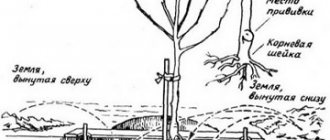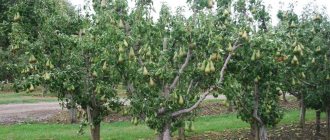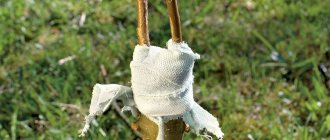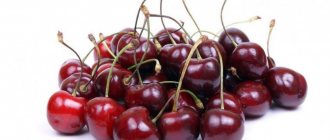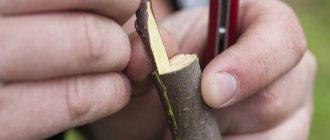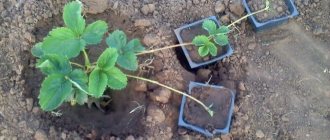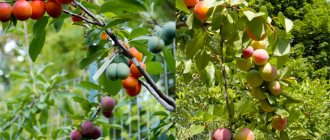Optimal season for apple tree grafting: spring or autumn
The period of time in which the gardener decides to make selection plays a decisive role. Action too early or too late can cause the tree to become sick or even die. It is certainly better to do this business in the spring, when all the vital juices of the plant are directed towards creation. But if it was not possible to get vaccinated during this period, you can reschedule it to a later date.
Compliance with deadlines and technology in this case must be strictly observed.
Apple tree grafting in September
Certain selection methods work well in the autumn months. So, for example, in September it is recommended to carry out budding , or to graft “behind the bark”. Also possible:
- copulation;
- cleft;
- semi-split
The timing of work must be selected depending on the growing region, weather conditions and the end of the tree growing season. In September, pinching is practiced in the northern regions, the Urals and Siberia. The work should be completed by the middle of the month.
In October
Autumn grafting is much more difficult than spring or summer grafting. And it must be carried out in a short time. In October, it is appropriate to carry out half-splitting or splitting , as well as copulation.
The procedure should be completed three weeks before the average daily temperature reaches +15 °C. If this condition is met, 95% survival rate of the scion can be achieved. Until the end of October, breeding activities can be carried out in the southern regions of the country.
Why vaccinate
Humanity learned to graft apple trees more than five thousand years ago. Thanks to selection, a large number of new varieties have been created that annually delight gardeners with their productivity. What attracts owners of summer cottages to graft apple trees?
- Grafting apple trees is an endless opportunity to conduct experiments in order to obtain new varieties or improve the varietal characteristics of an apple tree.
- Decreasing yield is another reason to renew an old tree and graft an apple tree in the fall.
- Thanks to grafting, you can propagate existing varieties and expand the range of trees growing in the garden.
- Has your apple tree started to dry out, hurt and have to be cut down? Do not rush to uproot the stump - you can graft several branches onto it and in a few years it will again delight you with fragrant fruits.
- Do you have a small plot where there is not enough space to grow enough of your favorite varieties of fruit trees? Do not despair! Thanks to grafting, up to 3-5 varieties can be grown on one apple tree.
- And one more plus. The apple tree is a very generous fruit tree. And sometimes it bears fruit so abundantly that gardeners don’t know what to do with the apples, distributing them to neighbors and friends. If on one apple tree you have several varieties with different ripening rates, then you will process the ripened harvest in a timely manner and without loss.
Interesting! The size of apples can vary significantly depending on the variety. The smallest apple is the size of a pea, the largest is the size of a newborn baby’s head.
Whatever the reason, all that remains is to learn how to properly plant an apple tree in the fall. And this process is not so complicated.
Goals and objectives of vaccination
The operation of apple tree propagation in the autumn season is directly related to the needs of gardening. Often, in dacha conditions, one of the following situations may arise:
- there is a desire to plant more apple trees of a particular variety;
- the size of the garden plot leaves much to be desired;
- there are no seedlings of the desired variety available for sale;
- there was a need to save your favorite tree from disease;
- the incorrect crown should be corrected;
- there was a desire to grow different varieties of apple trees with different ripening periods;
- it is necessary to improve the plant’s resistance to cold or increase its overall immunity;
- the spring or summer vaccination did not take root.
If the situation described in the above list has developed on the site, then selection activities carried out in the fall are fully justified.
Grafting goals
Grafting is a vegetative propagation method that involves connecting and fixing several fragments of a plant. The event provides an opportunity to obtain new varieties and improve the fruiting of trees. Objectives of the work:
- If the apple tree begins to bear fruit poorly, grafting will help improve the varietal characteristics.
- You can also graft a cut tree.
- Saving space in your garden plot - on 1 apple tree you can grow several varieties with different ripening periods.
Grafting allows you to preserve the variety of your favorite tree if the trunks are injured (eating by rodents, mistakes during care). The event will help obtain varieties of fruit trees that are unadapted to the climatic conditions of the region. In central Russia, southern crops can be cultivated if they are grafted onto frost-resistant varieties.
Preparation of tools and materials
Under no circumstances should you begin autumn grafting of apple trees until you have prepared all the necessary tools and materials.
For agricultural activities you will need:
- budding knife;
- copulating (grafting) pruning shears;
- garden knife;
- grafting hatchet;
- fixing material (insulating tape);
- garden var;
- plasticine.
All instruments must be carefully sharpened and disinfected.
Methods and sequence of vaccination
Experienced gardeners use different methods of implanting a scion into a rootstock. Several methods are considered the most common:
- budding,
- copulation is familiar to many,
- grafting into the cleft and “behind the bark”,
- implantation.
Grafting an apple tree in the fall, spring or at other times of the year with a bud is called budding. In the southern regions, it is recommended to carry out the procedure in the last days of March or early April, as soon as the first leaves appear. In the central and northern regions, where frosts are possible in early spring, budding is carried out from the beginning (mid) of August to the beginning of September with last year's dormant eye.
The best survival rate is shown by a dormant scion. An already awakened bud, cut from the uterine shoot, without receiving juices, often dries out.
The easiest way to graft a bud from a donor apple tree is to follow the following instructions step by step:
- On the rootstock, choose a branch growing at least half a meter from the ground.
- Using a sharp knife, make a T-shaped cut 2-3 mm deep on it. The length of the horizontal line should be 1 cm, the vertical line should be 2-2.5 cm.
- A pre-cut stalk without leaves is removed from a jar of water and the eye is cut off from it along with a piece of wood 1-2 mm thick and 2.-2.5 cm long.
- At the intersection of the cuts on the rootstock, the bark is lifted and the scion is applied to the exposed trunk.
- The grafting site is wrapped in cellophane so that the bud remains open.
If the operation was successful, after 2 weeks the eye will easily fall off when touched.
If it continues to firmly adhere to the “substrate”, the procedure should be repeated, choosing a place not far from the previous one.
Copulation for young apple trees
Copulation becomes popular when it is necessary to graft a young apple tree with cuttings 2-2.5 cm in diameter. The method is universal, as it can be used in any season, including winter. Copying is carried out in the following sequence:
- A cutting of the same thickness is selected for the rootstock.
- On both shoots, oblique cuts 3-4 cm long are made.
- The donor branch is applied to the rootstock so that the cuts coincide.
Cutting with improved copulation
- The grafting site is wrapped with tape or polyethylene, and open areas are treated with garden pitch.
There is also an improved version of this method. Its difference is that cuts 1 cm deep are made on the cutting and the scion branch. Then the resulting zigzag edges are connected so that they catch on each other.
Grafting into the cleft and “behind the bark”
This method is applied in early spring or at the height of summer and until mid-autumn (depending on the region) to trees 3-6 years old. They do it like this:
- In a skeletal branch from 2 to 5 cm thick, use an ax to make a split 5-7 cm deep and insert a spacer into it, for example, a nail or an awl.
- The end of the scion cutting is cut to the same length.
- The handle is inserted into the slot and the spacer is removed.
- The grafting site is covered with garden pitch, clay or plasticine and tied.
Sequence of work
Using the “by the bark” method, gardeners usually rejuvenate an old apple tree, the bark of which is easily separated from the trunk. When working, adhere to the following sequence of actions:
- 2-3 skeletal branches are left on the tree. The rest are cut down, leaving stumps 50-70 cm long.
- The cut areas are cleaned until smooth.
- The bark near the cut is cut by 4-6 cm and carefully moved using the handle of a knife.
- An oblique cut 4-5 cm long is made on the scion cutting and pressed against the trunk so that the cut part rises 1 mm above the cut.
- The grafting site is secured with tape and treated with garden varnish.
When is the best time to use this method to successfully graft an apple tree? In mid-autumn or early spring, as well as split grafting.
Implantation
The method is based on the use of scion and rootstock branches of the same diameter. They begin work by selecting a branch on the apple tree, which is located at least 20-25 cm from the ground. The cut is made at an angle of 45°. Then they select a shoot for the scion and cut out a cutting in its middle. The lower edge of the workpiece is combined with a cut prepared in advance on the apple tree, the upper edge is coated with garden varnish.
The cuttings and rootstock are tied with plastic tape, leaving the end with the garden varnish free. A plastic bag is attached to the resulting “stump” using a tie. Remove the bag when the first leaves appear on the branch.
Step-by-step instructions on how to plant apple trees in the fall for beginners
There are several basic methods of autumn vaccination that are guaranteed to give a positive result.
Budding method
This is grafting onto a healthy specimen of a new variety using a cutting from one bud. There are 2 ways of budding:
- in the cut;
- in the butt.
This method is recommended if the goal is to graft a cutting onto an old or young apple tree.
The procedure can also be carried out with another type of fruit crop. 3-year-old seedlings grown from seeds are ideal as a rootstock. Because they are already adapted to the weather conditions of a particular area. For the scion, we prepare the side shoots of an apple tree that bears fruit for at least 2 years. The thickness of the harvested material should not exceed 1.5 cm, the required length is 30 cm, 5 vegetative buds are left on each shoot. The sequence of actions in the vaccination process is as follows:
- Preliminary abundant watering of the rootstock.
- Cleaning the vaccination site.
- A T-shaped incision is made on the branch and the bark is pulled apart.
- A kind of shield is created from the scion, which should match the size of the cut.
- The shield is inserted into the incision so that the kidney is directed upward.
- The bark is straightened and wrapped with a fixing film.
- The fixing material is finally removed only in the spring.
Copulation method
With this method, you just need to clearly align the cuttings and seedlings with each other.
A 2-year-old wildflower is suitable as a rootstock. It should have the same diameter as the scion (about 5 cm). The scion and rootstock are cut with a special grafting pruner at an angle of 30° and connected so that their cambial layers completely coincide.
The grafting site is secured with electrical tape or twine. Offset application will result in failure of fusion.
Split and half split method
A split is a cut in the rootstock made to accommodate the insertion of a cutting.
If grafting is carried out in a split, then the dissection is carried out along the entire rootstock, but if in a half-split, then the rootstock is opened only on one side. This method is justified when the rootstock and scion have different ages and diameters. In this way, old trees are most often renovated by grafting young branches onto them, and several young cuttings are also grafted onto a stump at once.
Budding method
The budding method also has another name – “eye” grafting. An eye is a bud that is grafted onto the rootstock. A rootstock is a plant to which a bud from another tree is attached. This method can be carried out without the use of cuttings, which is very convenient if grafting material is not available. The budding procedure should be carried out quickly and as carefully as possible. Only a healthy bud is grafted, which is cut off along with a piece of wood. This piece of wood is called a shield.
Attention!
When carrying out budding, it is important not to confuse the direction in which the bud is growing. She must look up.
Preparing the rootstock and scion
May be interesting Features and rules for planting apple trees in autumn in the Leningrad region Is it necessary to cover an apple tree for the winter and how to do it correctly Rejuvenation of apple trees by pruning: diagrams and technologies
The first step is to select a suitable place with smooth bark on the tree to be grafted onto - the rootstock. There should be no swelling, swelling or knots. It is necessary to graft in a place located from the surface of the earth at a distance of 8 cm for seed rootstock and 15 cm for clonal rootstock. It is undesirable to choose sharp bends; grafting is carried out below the bend of the branch or trunk. Then the rootstock is prepared, cleaned of dirt and dust, and a T-shaped cut is made. To do this, cut the bark 1.5 cm in length in the transverse direction. 3 cm are retreated from the middle of the cut and cut from the bottom up, reaching the center of the transverse cut, turn the knife and carefully separate the bark from the tree along the longitudinal cut.
For the procedure to be successful, the harvested cuttings must be of high quality. To graft apple trees in the fall, it is necessary to take the eyes (buds) that appeared in the summer, but which will begin to grow only next spring. That's why they are called sleepers. They are mainly found on semi-lignified shoots of one year of life. To carry out autumn budding, it is from them that a piece of bark is cut off along with the eye. Holding a part of an annual shoot 15-20 cm long in your hand, make a transverse cut under the bud. You need to retreat 1.5 cm from and above it and cut off the shield along with a thin layer of wood. Do it quickly, carefully, without sudden movements. The manipulation can only be performed with one deft movement using a sharp instrument.
Connection of scion to rootstock
To connect the scion and rootstock, the first is inserted into a T-shaped cut. You need to make sure that the eye is looking up, then press down its edges with bark. Leave the kidney clearly in the center. The place where the budding was done is wrapped with plastic tape. The shield cannot be moved. The kidney itself is not wrapped. After 14-18 days, you need to check how the procedure went. The fact that the budding was unsuccessful can be judged by the dried out or rotten scion. Then it is removed, the place where it was located is cleaned and treated with garden putty. Next time you can try to graft an apple tree by budding only in the spring.
Tree care after grafting
Grafted fruit trees, regardless of processing technology, require proper subsequent care. A responsible gardener should:
- After 3 weeks, loosen the winding material.
- In spring, remove the winding completely.
- Water and feed grafted trees in a timely manner.
- Provide protection from pests and frost.
- Install bird fences for young parts of plantings.
- Pinch off the tops.
The best time for vaccination
Donor material can be implanted into the rootstock year-round. However, each season has its own characteristics and limitations.
- Experienced gardeners try to graft apple trees in the spring. This time is considered the best for several factors:
– during sap flow, the scions take root well;
– the cut sites of the donor and the rootstock heal faster;
– in case of failure, it is possible to repeat the manipulation in the summer of the same year.
The operation time depends on the material. As soon as the frosts end, the apple trees will be grafted with cuttings. For the middle zone, the dates from the end of March or the beginning of April are suitable. The implantation of the eye, or bud, is carried out in early May. In the southern regions these dates are shifted by 2 weeks.
- In the summer, vaccination with a “sleeping” eye is timed to coincide with the beginning of the 2nd sap flow, namely:
– in mid-August – in the Central regions and Moscow region;
– at the end of August or beginning of September – in the south;
- early August - in Siberia.
Using the peephole
- Autumn is an unlucky period for grafting garden trees. Their sap flow slows down and, accordingly, the survival rate of the donor material decreases. This season is chosen if there is an opportunity to take a good scion, but there is nowhere to store it until spring.
When grafting apple trees in autumn, it is important to take into account 2 criteria:
- Only young trees can be grafted.
- If there is a threat of early cold weather, the procedure should be postponed until spring, since the scion should be in a new place 2-3 weeks before severe frosts.
At what time are apple trees grafted in the fall? To select the timing correctly, take into account the location of the region:
– at the end of September or beginning of October – in the Central region;
– at the end of October and with the arrival of November – in the south;
- early or mid-September - in the northern regions.
- Is it possible to graft apple trees in winter? Yes, but only for seedlings and in a room with above-zero temperatures. Winter selection work is carried out from January to March. Moreover, 2-3 weeks before planting the seedlings in a permanent place, all procedures are completed.
Video about summer vaccination work.
Preparing cuttings for autumn grafting
Cuttings of the required variety for grafting apple trees should be prepared during the ripening of the fruit. Choose branches from unshaded areas of the crown. The appropriate cutting length should be from 25 to 30 cm. 5 live buds should be left on each of them. The upper parts of young, not completely lignified shoots, the diameter of which is no more than 9 cm, are best suited.
Before grafting, store the finished material wrapped in damp material.
Cut cuttings need to be provided with the correct conditions. Arrange them in bunches according to variety and place them in a cool basement. The air temperature should be no higher than 3 degrees Celsius. The lower ends of the shoots should be placed in boxes with wet sand.
Do not prepare cuttings for grafting from diseased parts of the tree or from tops.
When to vaccinate an apple tree
The procedure for correctly grafting an apple tree in the fall is quite difficult, but it is also not as difficult as doing the same thing in spring or summer. Advantages of autumn vaccination:
- Seedlings grafted with clefts tolerate climate changes more easily;
- It is much more likely that the grafted parts will be able to take root without significant losses;
- Significant time savings if this was not done in summer or spring.
- Temperature conditions in terms of humidity and heat are considered optimal.
The best time will be the first days of September, when sap is still flowing and the leaves have not yet completely fallen off. The grafted branch must have time to settle down before the first frost. Otherwise, she will die and will have to wait until spring for a second grafting.
The cuttings must be prepared in advance; it is best to cut a branch 40 centimeters long from a one-year-old shoot. The bark must be cleaned of dirt; it is advisable to do everything in the morning in cloudy weather .
The resulting scion should be stored in peat or sawdust in a dry place at a low temperature, occasionally watering the substrate. This will allow the branches to maintain a decent appearance, be fresh and swollen.
What can you graft an apple tree on in the fall?
You can graft an apple tree in the fall onto a rootstock grown in advance from seeds. In addition, the procedure can be carried out vegetatively. Excellent rootstocks can be seedlings of wild or cultivated trees, vigorous clones or universal seedlings. To increase winter resistance, it is recommended to graft a summer variety with an autumn variety, and an autumn variety with a winter one. You can also connect related trees according to their ripening dates. And to increase durability, it is necessary to take into account varietal differences.
On an old tree
A tree no older than 25 years is suitable for grafting apple trees. It will “marry” well with neighboring varieties. It is recommended to extend the procedure over 2–3 years. Up to 3 cuttings can be planted on skeletal branches. You can also cut down an old tree and place grafts on the stump.
To the mountain ash
This genus of plants belongs to the Apple tribe, so rowan is excellent for breeding a popular fruit tree. Dwarf varieties, for example, Chinese, can be grafted onto it.
For a 2-year-old wild apple tree
Do not forget about the preliminary rooting of wildflowers in the open ground. Before using it as a rootstock, it must germinate in a new location for at least a year. This material is suitable for the following methods: budding, under bark, in clefts.
On a stump
A fresh stump can be used as a base when grafting into a split or behind the bark. It is perfect for creating a tree with a crown-shaped bowl. Up to 5 different varieties can be grafted onto 1 stump.
To the small ranetka
This unpretentious variety is frost-resistant, stable in rainy years and drought. It is also undemanding to soil quality. All these qualities make ranetka an excellent rootstock option.
To the pear
The pear and apple tree are equal inhabitants of the garden; they are similar in their biological characteristics. You just need to understand the growing season of the varieties in order to combine the growth of the wood.
Necessity of vaccination
Thanks to grafting, it is possible to acquire new varieties of apples, improve varietal characteristics, and renew an old tree. It becomes possible to propagate varieties already available in the garden. There is no need to rush to dig up a tree that is beginning to dry out. If you graft apple tree branches onto a cut stump, then after a few years a new harvest will appear on them. In a garden where there is no room for several varieties, from 3 to 5 types of apples are grown on one tree. The apple tree is a tree that bears fruit abundantly, so it is very convenient if the fruits on it ripen at different times. If there are no fruit trees in the garden, it is grafted onto:
- hawthorn and viburnum;
- pear and quince;
- chokeberry and common rowan.
However, if any of these seedlings is chosen as a rootstock, the scion takes root difficultly, the fruits are gradually crushed, their number will decrease, and the fruiting period will become shorter. In order to be able to collect many fruits that taste great and have a magnificent appearance in the future, it is necessary to graft apple seedlings and mature apple trees onto 2- and 3-year-old trees. Wild ones and seedlings of cultivated varieties are well suited.
